Attached files
| file | filename |
|---|---|
| EX-99.1 - EX-99.1 - Apollo Commercial Real Estate Finance, Inc. | d351904dex991.htm |
| 8-K - 8-K - Apollo Commercial Real Estate Finance, Inc. | d351904d8k.htm |
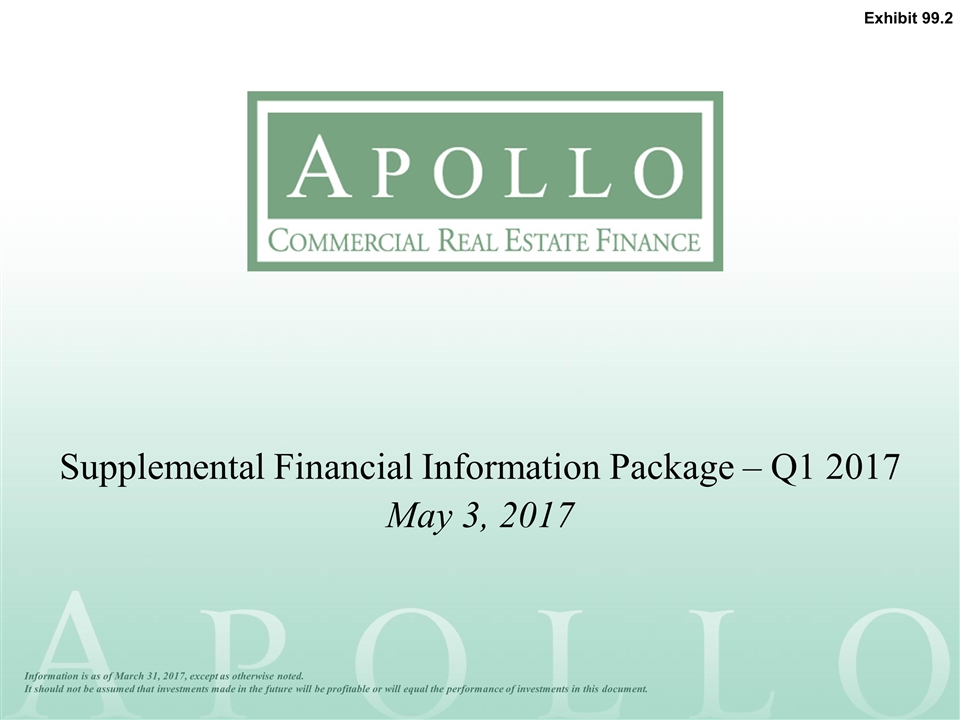
Information is as of March 31, 2017, except as otherwise noted. It should not be assumed that investments made in the future will be profitable or will equal the performance of investments in this document. Supplemental Financial Information Package – Q1 2017 May 3, 2017 Exhibit 99.2
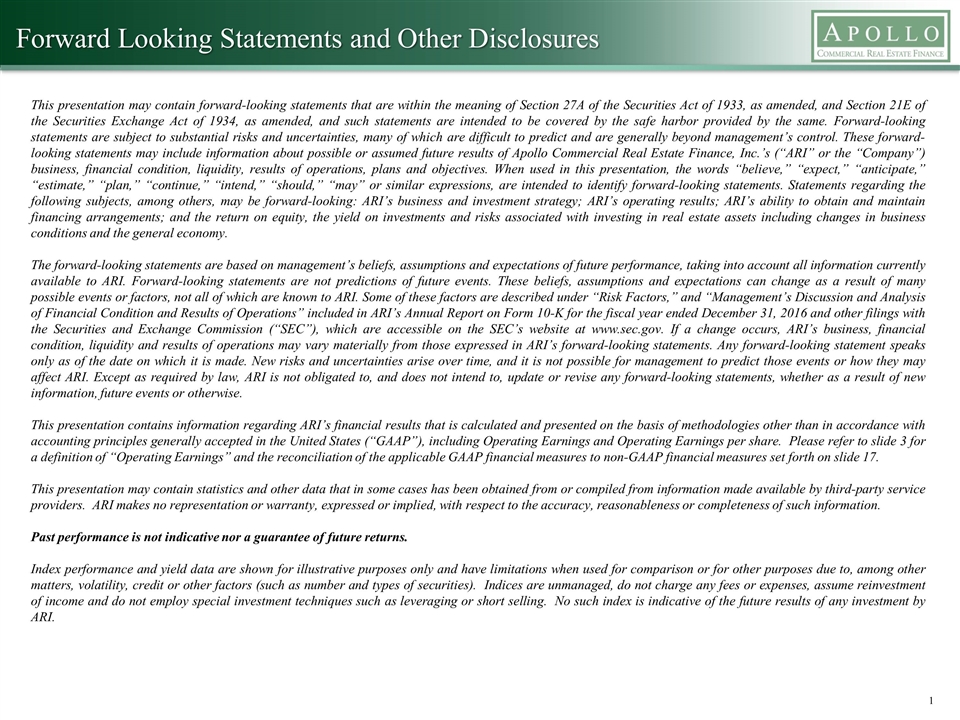
Forward Looking Statements and Other Disclosures This presentation may contain forward-looking statements that are within the meaning of Section 27A of the Securities Act of 1933, as amended, and Section 21E of the Securities Exchange Act of 1934, as amended, and such statements are intended to be covered by the safe harbor provided by the same. Forward-looking statements are subject to substantial risks and uncertainties, many of which are difficult to predict and are generally beyond management’s control. These forward-looking statements may include information about possible or assumed future results of Apollo Commercial Real Estate Finance, Inc.’s (“ARI” or the “Company”) business, financial condition, liquidity, results of operations, plans and objectives. When used in this presentation, the words “believe,” “expect,” “anticipate,” “estimate,” “plan,” “continue,” “intend,” “should,” “may” or similar expressions, are intended to identify forward-looking statements. Statements regarding the following subjects, among others, may be forward-looking: ARI’s business and investment strategy; ARI’s operating results; ARI’s ability to obtain and maintain financing arrangements; and the return on equity, the yield on investments and risks associated with investing in real estate assets including changes in business conditions and the general economy. The forward-looking statements are based on management’s beliefs, assumptions and expectations of future performance, taking into account all information currently available to ARI. Forward-looking statements are not predictions of future events. These beliefs, assumptions and expectations can change as a result of many possible events or factors, not all of which are known to ARI. Some of these factors are described under “Risk Factors,” and “Management’s Discussion and Analysis of Financial Condition and Results of Operations” included in ARI’s Annual Report on Form 10-K for the fiscal year ended December 31, 2016 and other filings with the Securities and Exchange Commission (“SEC”), which are accessible on the SEC’s website at www.sec.gov. If a change occurs, ARI’s business, financial condition, liquidity and results of operations may vary materially from those expressed in ARI’s forward-looking statements. Any forward-looking statement speaks only as of the date on which it is made. New risks and uncertainties arise over time, and it is not possible for management to predict those events or how they may affect ARI. Except as required by law, ARI is not obligated to, and does not intend to, update or revise any forward-looking statements, whether as a result of new information, future events or otherwise. This presentation contains information regarding ARI’s financial results that is calculated and presented on the basis of methodologies other than in accordance with accounting principles generally accepted in the United States (“GAAP”), including Operating Earnings and Operating Earnings per share. Please refer to slide 3 for a definition of “Operating Earnings” and the reconciliation of the applicable GAAP financial measures to non-GAAP financial measures set forth on slide 17. This presentation may contain statistics and other data that in some cases has been obtained from or compiled from information made available by third-party service providers. ARI makes no representation or warranty, expressed or implied, with respect to the accuracy, reasonableness or completeness of such information. Past performance is not indicative nor a guarantee of future returns. Index performance and yield data are shown for illustrative purposes only and have limitations when used for comparison or for other purposes due to, among other matters, volatility, credit or other factors (such as number and types of securities). Indices are unmanaged, do not charge any fees or expenses, assume reinvestment of income and do not employ special investment techniques such as leveraging or short selling. No such index is indicative of the future results of any investment by ARI.
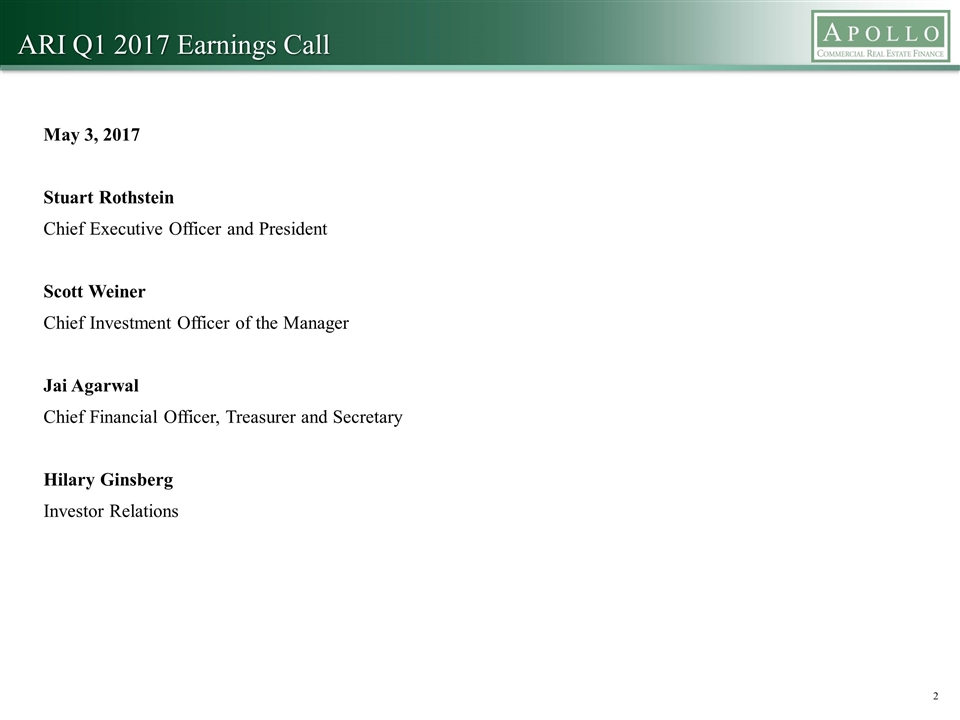
ARI Q1 2017 Earnings Call May 3, 2017 Stuart Rothstein Chief Executive Officer and President Scott Weiner Chief Investment Officer of the Manager Jai Agarwal Chief Financial Officer, Treasurer and Secretary Hilary Ginsberg Investor Relations
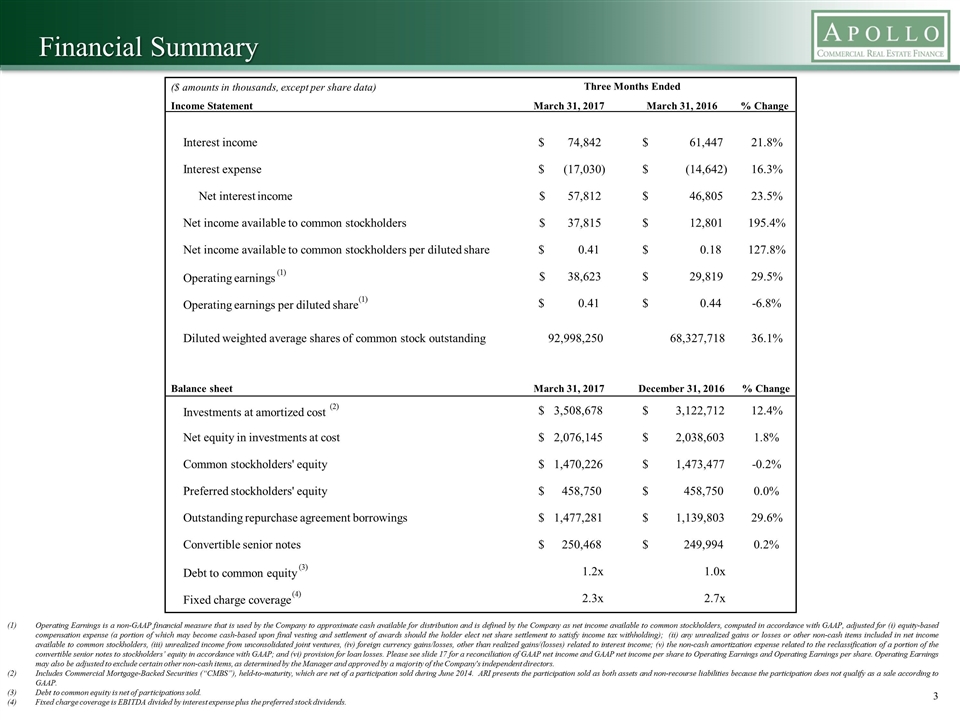
Financial Summary Operating Earnings is a non-GAAP financial measure that is used by the Company to approximate cash available for distribution and is defined by the Company as net income available to common stockholders, computed in accordance with GAAP, adjusted for (i) equity-based compensation expense (a portion of which may become cash-based upon final vesting and settlement of awards should the holder elect net share settlement to satisfy income tax withholding); (ii) any unrealized gains or losses or other non-cash items included in net income available to common stockholders, (iii) unrealized income from unconsolidated joint ventures, (iv) foreign currency gains/losses, other than realized gains/(losses) related to interest income; (v) the non-cash amortization expense related to the reclassification of a portion of the convertible senior notes to stockholders’ equity in accordance with GAAP; and (vi) provision for loan losses. Please see slide 17 for a reconciliation of GAAP net income and GAAP net income per share to Operating Earnings and Operating Earnings per share. Operating Earnings may also be adjusted to exclude certain other non-cash items, as determined by the Manager and approved by a majority of the Company's independent directors. Includes Commercial Mortgage-Backed Securities (“CMBS”), held-to-maturity, which are net of a participation sold during June 2014. ARI presents the participation sold as both assets and non-recourse liabilities because the participation does not qualify as a sale according to GAAP. Debt to common equity is net of participations sold. Fixed charge coverage is EBITDA divided by interest expense plus the preferred stock dividends. ($ amounts in thousands, except per share data) Income Statement March 31, 2017 March 31, 2016 % Change 74,842 $ 61,447 $ 21.8% (17,030) $ (14,642) $ 16.3% Net interest income 57,812 $ 46,805 $ 23.5% Net income available to common stockholders 37,815 $ 12,801 $ 195.4% Net income available to common stockholders per diluted share 0.41 $ 0.18 $ 127.8% Operating earnings (1) 38,623 $ 29,819 $ 29.5% 0.41 $ 0.44 $ -6.8% 92,998,250 68,327,718 36.1% Balance sheet March 31, 2017 December 31, 2016 % Change 3,508,678 $ 3,122,712 $ 12.4% 2,076,145 $ 2,038,603 $ 1.8% Common stockholders' equity 1,470,226 $ 1,473,477 $ -0.2% 458,750 $ 458,750 $ 0.0% 1,477,281 $ 1,139,803 $ 29.6% Convertible senior notes 250,468 $ 249,994 $ 0.2% 1.2x 1.0x 2.3x 2.7x Three Months Ended Interest income Interest expense Diluted weighted average shares of common stock outstanding Investments at amortized cost (2) Net equity in investments at cost Preferred stockholders' equity Debt to common equity (3) Outstanding repurchase agreement borrowings Fixed charge coverage (4) Operating earnings per diluted share (1)
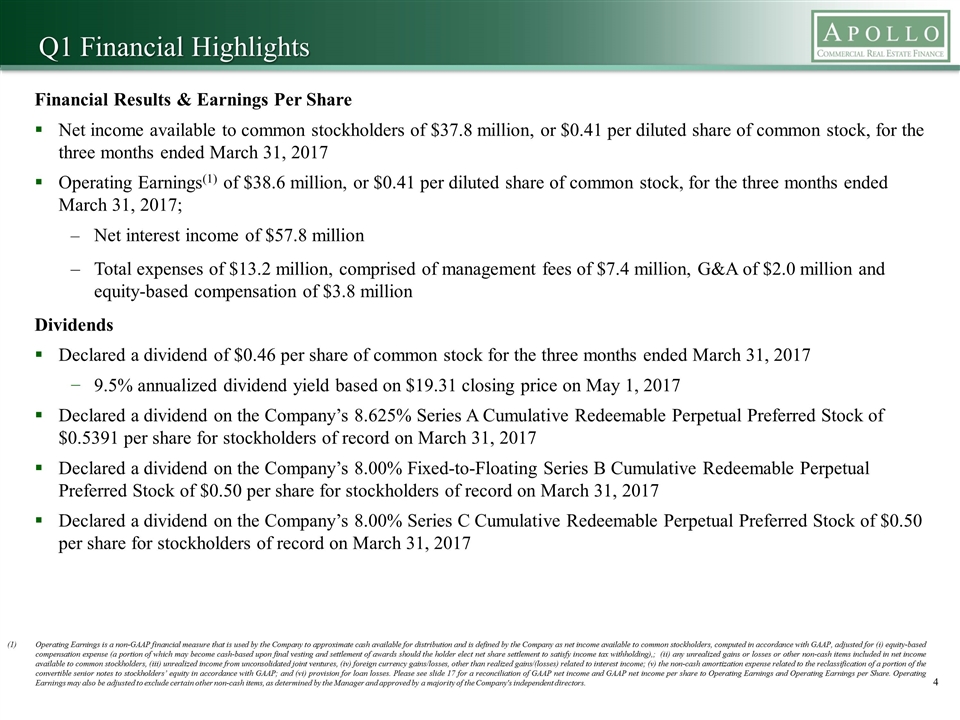
Q1 Financial Highlights Financial Results & Earnings Per Share Net income available to common stockholders of $37.8 million, or $0.41 per diluted share of common stock, for the three months ended March 31, 2017 Operating Earnings(1) of $38.6 million, or $0.41 per diluted share of common stock, for the three months ended March 31, 2017; Net interest income of $57.8 million Total expenses of $13.2 million, comprised of management fees of $7.4 million, G&A of $2.0 million and equity-based compensation of $3.8 million Dividends Declared a dividend of $0.46 per share of common stock for the three months ended March 31, 2017 9.5% annualized dividend yield based on $19.31 closing price on May 1, 2017 Declared a dividend on the Company’s 8.625% Series A Cumulative Redeemable Perpetual Preferred Stock of $0.5391 per share for stockholders of record on March 31, 2017 Declared a dividend on the Company’s 8.00% Fixed-to-Floating Series B Cumulative Redeemable Perpetual Preferred Stock of $0.50 per share for stockholders of record on March 31, 2017 Declared a dividend on the Company’s 8.00% Series C Cumulative Redeemable Perpetual Preferred Stock of $0.50 per share for stockholders of record on March 31, 2017 Operating Earnings is a non-GAAP financial measure that is used by the Company to approximate cash available for distribution and is defined by the Company as net income available to common stockholders, computed in accordance with GAAP, adjusted for (i) equity-based compensation expense (a portion of which may become cash-based upon final vesting and settlement of awards should the holder elect net share settlement to satisfy income tax withholding),; (ii) any unrealized gains or losses or other non-cash items included in net income available to common stockholders, (iii) unrealized income from unconsolidated joint ventures, (iv) foreign currency gains/losses, other than realized gains/(losses) related to interest income; (v) the non-cash amortization expense related to the reclassification of a portion of the convertible senior notes to stockholders’ equity in accordance with GAAP; and (vi) provision for loan losses. Please see slide 17 for a reconciliation of GAAP net income and GAAP net income per share to Operating Earnings and Operating Earnings per Share. Operating Earnings may also be adjusted to exclude certain other non-cash items, as determined by the Manager and approved by a majority of the Company's independent directors.
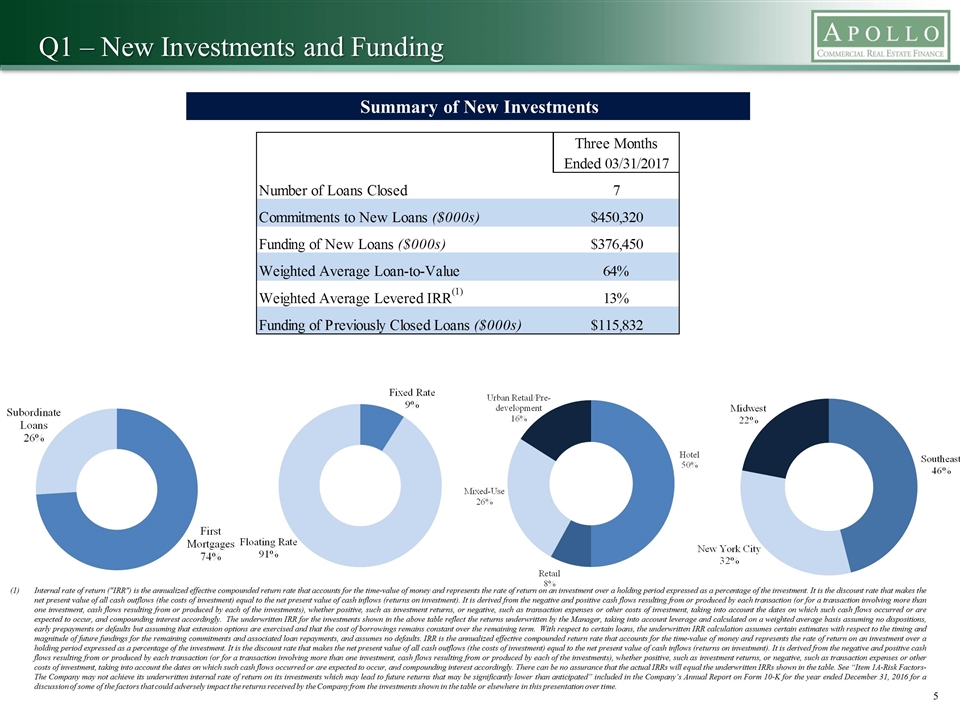
Q1 – New Investments and Funding Summary of New Investments Internal rate of return ("IRR") is the annualized effective compounded return rate that accounts for the time-value of money and represents the rate of return on an investment over a holding period expressed as a percentage of the investment. It is the discount rate that makes the net present value of all cash outflows (the costs of investment) equal to the net present value of cash inflows (returns on investment). It is derived from the negative and positive cash flows resulting from or produced by each transaction (or for a transaction involving more than one investment, cash flows resulting from or produced by each of the investments), whether positive, such as investment returns, or negative, such as transaction expenses or other costs of investment, taking into account the dates on which such cash flows occurred or are expected to occur, and compounding interest accordingly. The underwritten IRR for the investments shown in the above table reflect the returns underwritten by the Manager, taking into account leverage and calculated on a weighted average basis assuming no dispositions, early prepayments or defaults but assuming that extension options are exercised and that the cost of borrowings remains constant over the remaining term. With respect to certain loans, the underwritten IRR calculation assumes certain estimates with respect to the timing and magnitude of future fundings for the remaining commitments and associated loan repayments, and assumes no defaults. IRR is the annualized effective compounded return rate that accounts for the time-value of money and represents the rate of return on an investment over a holding period expressed as a percentage of the investment. It is the discount rate that makes the net present value of all cash outflows (the costs of investment) equal to the net present value of cash inflows (returns on investment). It is derived from the negative and positive cash flows resulting from or produced by each transaction (or for a transaction involving more than one investment, cash flows resulting from or produced by each of the investments), whether positive, such as investment returns, or negative, such as transaction expenses or other costs of investment, taking into account the dates on which such cash flows occurred or are expected to occur, and compounding interest accordingly. There can be no assurance that the actual IRRs will equal the underwritten IRRs shown in the table. See “Item 1A-Risk Factors-The Company may not achieve its underwritten internal rate of return on its investments which may lead to future returns that may be significantly lower than anticipated” included in the Company’s Annual Report on Form 10-K for the year ended December 31, 2016 for a discussion of some of the factors that could adversely impact the returns received by the Company from the investments shown in the table or elsewhere in this presentation over time.
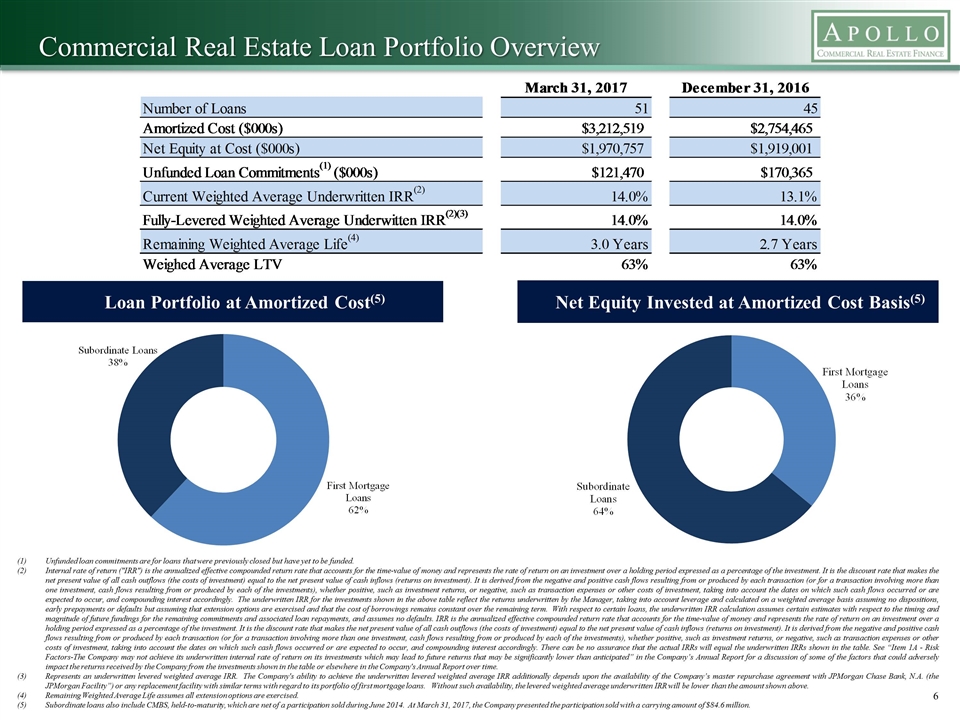
Commercial Real Estate Loan Portfolio Overview Unfunded loan commitments are for loans that were previously closed but have yet to be funded. Internal rate of return ("IRR") is the annualized effective compounded return rate that accounts for the time-value of money and represents the rate of return on an investment over a holding period expressed as a percentage of the investment. It is the discount rate that makes the net present value of all cash outflows (the costs of investment) equal to the net present value of cash inflows (returns on investment). It is derived from the negative and positive cash flows resulting from or produced by each transaction (or for a transaction involving more than one investment, cash flows resulting from or produced by each of the investments), whether positive, such as investment returns, or negative, such as transaction expenses or other costs of investment, taking into account the dates on which such cash flows occurred or are expected to occur, and compounding interest accordingly. The underwritten IRR for the investments shown in the above table reflect the returns underwritten by the Manager, taking into account leverage and calculated on a weighted average basis assuming no dispositions, early prepayments or defaults but assuming that extension options are exercised and that the cost of borrowings remains constant over the remaining term. With respect to certain loans, the underwritten IRR calculation assumes certain estimates with respect to the timing and magnitude of future fundings for the remaining commitments and associated loan repayments, and assumes no defaults. IRR is the annualized effective compounded return rate that accounts for the time-value of money and represents the rate of return on an investment over a holding period expressed as a percentage of the investment. It is the discount rate that makes the net present value of all cash outflows (the costs of investment) equal to the net present value of cash inflows (returns on investment). It is derived from the negative and positive cash flows resulting from or produced by each transaction (or for a transaction involving more than one investment, cash flows resulting from or produced by each of the investments), whether positive, such as investment returns, or negative, such as transaction expenses or other costs of investment, taking into account the dates on which such cash flows occurred or are expected to occur, and compounding interest accordingly. There can be no assurance that the actual IRRs will equal the underwritten IRRs shown in the table. See “Item 1A - Risk Factors-The Company may not achieve its underwritten internal rate of return on its investments which may lead to future returns that may be significantly lower than anticipated” in the Company’s Annual Report for a discussion of some of the factors that could adversely impact the returns received by the Company from the investments shown in the table or elsewhere in the Company's Annual Report over time. Represents an underwritten levered weighted average IRR. The Company's ability to achieve the underwritten levered weighted average IRR additionally depends upon the availability of the Company’s master repurchase agreement with JPMorgan Chase Bank, N.A. (the JPMorgan Facility”) or any replacement facility with similar terms with regard to its portfolio of first mortgage loans. Without such availability, the levered weighted average underwritten IRR will be lower than the amount shown above. Remaining Weighted Average Life assumes all extension options are exercised. Subordinate loans also include CMBS, held-to-maturity, which are net of a participation sold during June 2014. At March 31, 2017, the Company presented the participation sold with a carrying amount of $84.6 million. Net Equity Invested at Amortized Cost Basis(5) Loan Portfolio at Amortized Cost(5)
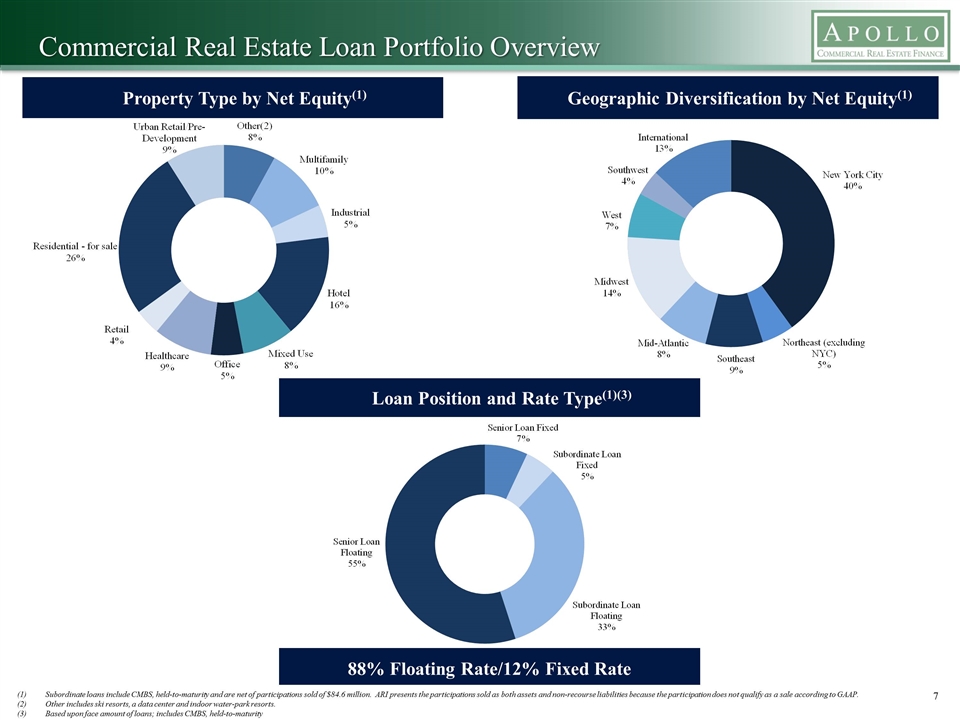
Commercial Real Estate Loan Portfolio Overview Geographic Diversification by Net Equity(1) Property Type by Net Equity(1) Subordinate loans include CMBS, held-to-maturity and are net of participations sold of $84.6 million. ARI presents the participations sold as both assets and non-recourse liabilities because the participation does not qualify as a sale according to GAAP. Other includes ski resorts, a data center and indoor water-park resorts. Based upon face amount of loans; includes CMBS, held-to-maturity Loan Position and Rate Type(1)(3) 88% Floating Rate/12% Fixed Rate
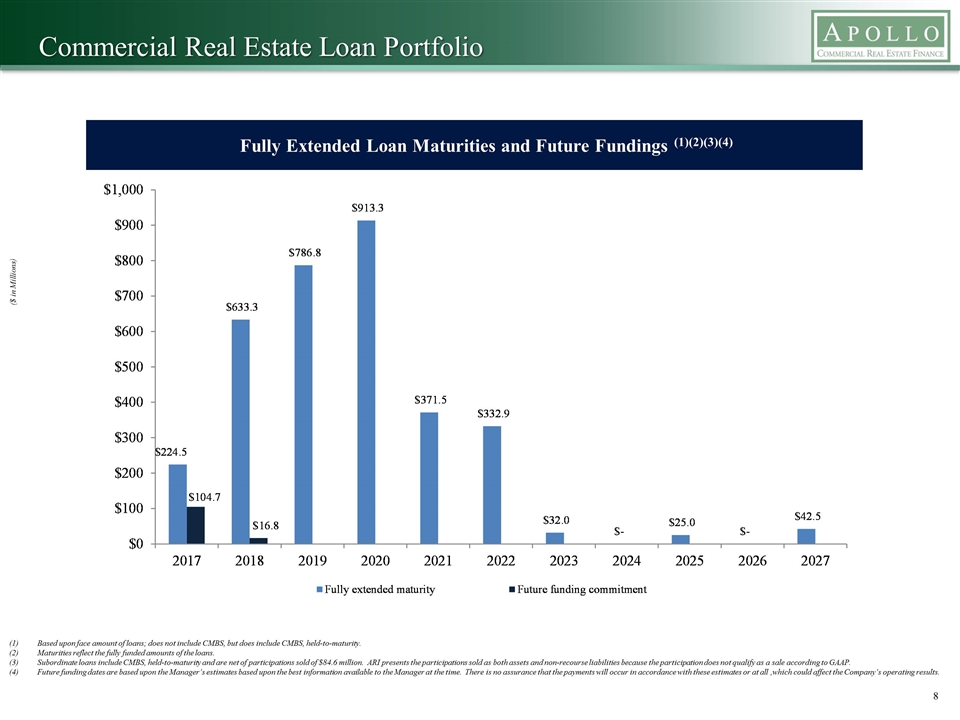
Commercial Real Estate Loan Portfolio ($ in Millions) Fully Extended Loan Maturities and Future Fundings (1)(2)(3)(4) Based upon face amount of loans; does not include CMBS, but does include CMBS, held-to-maturity. Maturities reflect the fully funded amounts of the loans. Subordinate loans include CMBS, held-to-maturity and are net of participations sold of $84.6 million. ARI presents the participations sold as both assets and non-recourse liabilities because the participation does not qualify as a sale according to GAAP. Future funding dates are based upon the Manager’s estimates based upon the best information available to the Manager at the time. There is no assurance that the payments will occur in accordance with these estimates or at all ,which could affect the Company’s operating results.
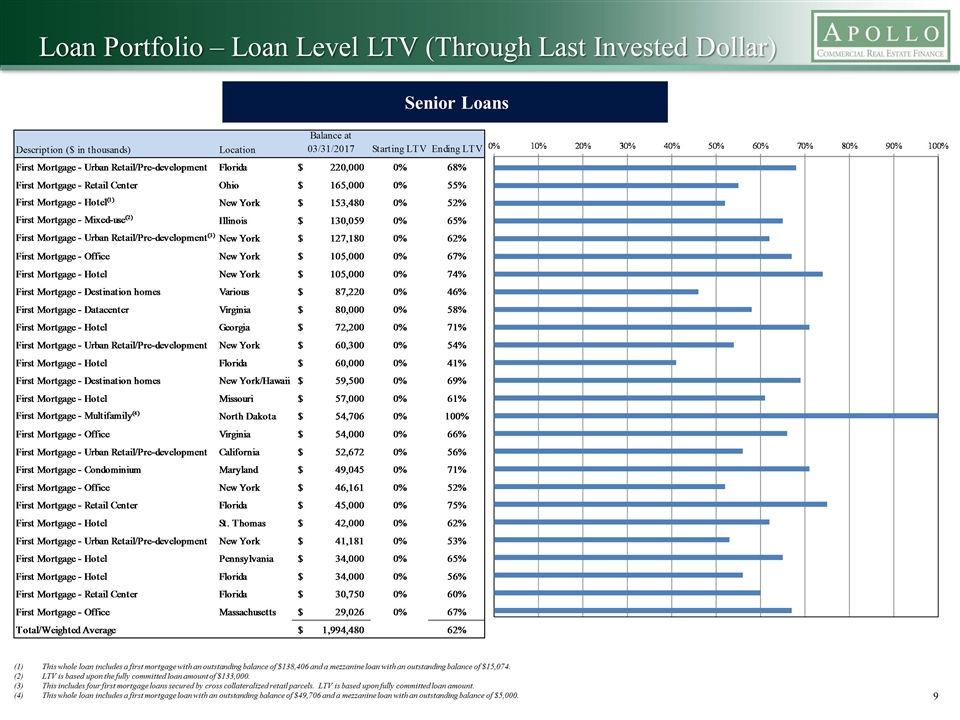
Loan Portfolio – Loan Level LTV (Through Last Invested Dollar) Senior Loans This whole loan includes a first mortgage with an outstanding balance of $138,406 and a mezzanine loan with an outstanding balance of $15,074. LTV is based upon the fully committed loan amount of $133,000. This includes four first mortgage loans secured by cross collateralized retail parcels. LTV is based upon fully committed loan amount. This whole loan includes a first mortgage loan with an outstanding balance of $49,706 and a mezzanine loan with an outstanding balance of $5,000.
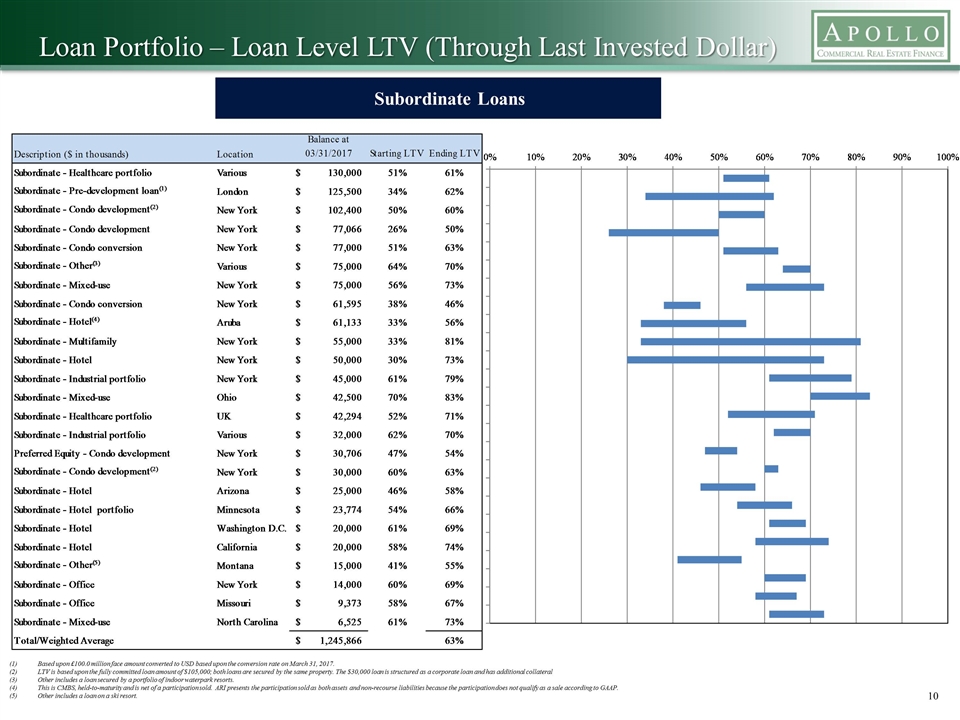
Loan Portfolio – Loan Level LTV (Through Last Invested Dollar) Subordinate Loans Based upon £100.0 million face amount converted to USD based upon the conversion rate on March 31, 2017. LTV is based upon the fully committed loan amount of $105,000; both loans are secured by the same property. The $30,000 loan is structured as a corporate loan and has additional collateral Other includes a loan secured by a portfolio of indoor waterpark resorts. This is CMBS, held-to-maturity and is net of a participation sold. ARI presents the participation sold as both assets and non-recourse liabilities because the participation does not qualify as a sale according to GAAP. Other includes a loan on a ski resort.
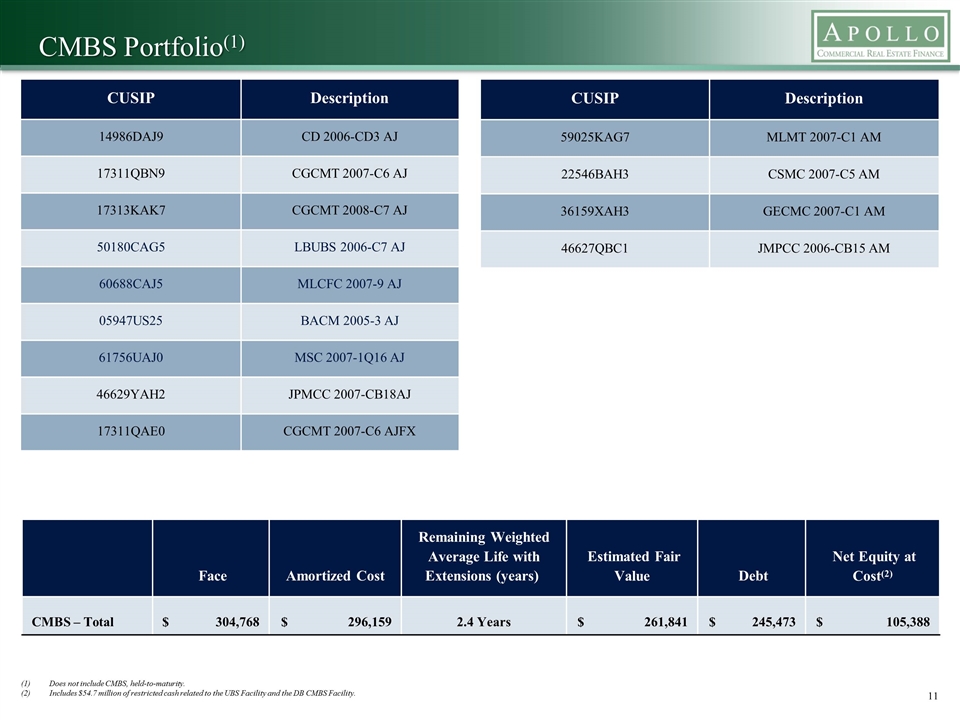
CMBS Portfolio(1) Face Amortized Cost Remaining Weighted Average Life with Extensions (years) Estimated Fair Value Debt Net Equity at Cost(2) CMBS – Total $ 304,768 $ 296,159 2.4 Years $ 261,841 $ 245,473 $ 105,388 CUSIP Description 14986DAJ9 CD 2006-CD3 AJ 17311QBN9 CGCMT 2007-C6 AJ 17313KAK7 CGCMT 2008-C7 AJ 50180CAG5 LBUBS 2006-C7 AJ 60688CAJ5 MLCFC 2007-9 AJ 05947US25 BACM 2005-3 AJ 61756UAJ0 MSC 2007-1Q16 AJ 46629YAH2 JPMCC 2007-CB18AJ 17311QAE0 CGCMT 2007-C6 AJFX CUSIP Description 59025KAG7 MLMT 2007-C1 AM 22546BAH3 CSMC 2007-C5 AM 36159XAH3 GECMC 2007-C1 AM 46627QBC1 JMPCC 2006-CB15 AM Does not include CMBS, held-to-maturity. Includes $54.7 million of restricted cash related to the UBS Facility and the DB CMBS Facility.
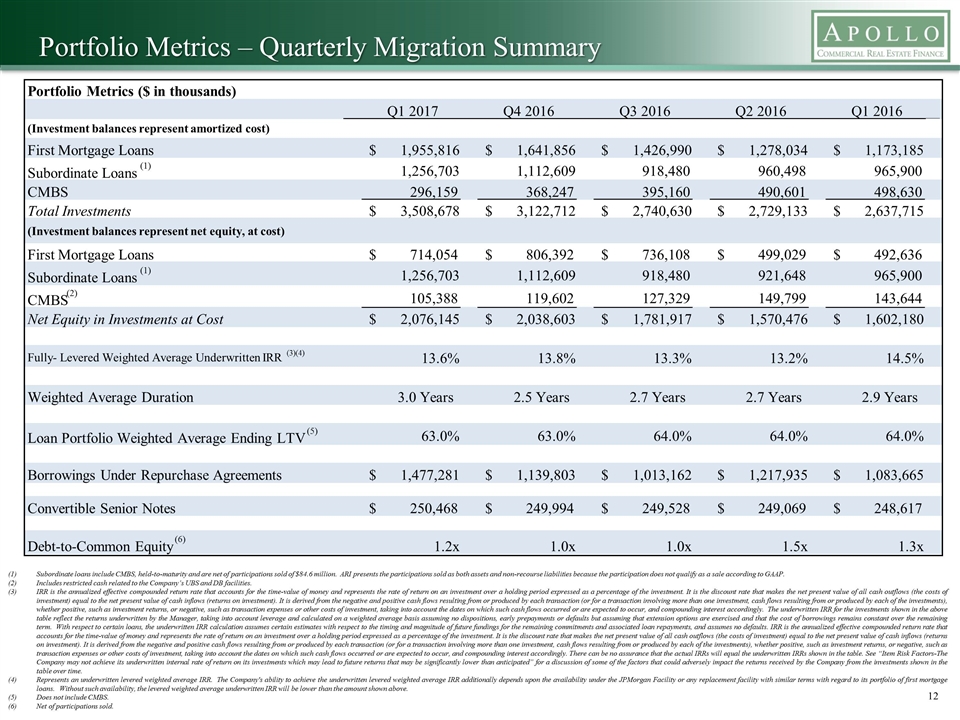
Portfolio Metrics – Quarterly Migration Summary Subordinate loans include CMBS, held-to-maturity and are net of participations sold of $84.6 million. ARI presents the participations sold as both assets and non-recourse liabilities because the participation does not qualify as a sale according to GAAP. Includes restricted cash related to the Company’s UBS and DB facilities. IRR is the annualized effective compounded return rate that accounts for the time-value of money and represents the rate of return on an investment over a holding period expressed as a percentage of the investment. It is the discount rate that makes the net present value of all cash outflows (the costs of investment) equal to the net present value of cash inflows (returns on investment). It is derived from the negative and positive cash flows resulting from or produced by each transaction (or for a transaction involving more than one investment, cash flows resulting from or produced by each of the investments), whether positive, such as investment returns, or negative, such as transaction expenses or other costs of investment, taking into account the dates on which such cash flows occurred or are expected to occur, and compounding interest accordingly. The underwritten IRR for the investments shown in the above table reflect the returns underwritten by the Manager, taking into account leverage and calculated on a weighted average basis assuming no dispositions, early prepayments or defaults but assuming that extension options are exercised and that the cost of borrowings remains constant over the remaining term. With respect to certain loans, the underwritten IRR calculation assumes certain estimates with respect to the timing and magnitude of future fundings for the remaining commitments and associated loan repayments, and assumes no defaults. IRR is the annualized effective compounded return rate that accounts for the time-value of money and represents the rate of return on an investment over a holding period expressed as a percentage of the investment. It is the discount rate that makes the net present value of all cash outflows (the costs of investment) equal to the net present value of cash inflows (returns on investment). It is derived from the negative and positive cash flows resulting from or produced by each transaction (or for a transaction involving more than one investment, cash flows resulting from or produced by each of the investments), whether positive, such as investment returns, or negative, such as transaction expenses or other costs of investment, taking into account the dates on which such cash flows occurred or are expected to occur, and compounding interest accordingly. There can be no assurance that the actual IRRs will equal the underwritten IRRs shown in the table. See “Item Risk Factors-The Company may not achieve its underwritten internal rate of return on its investments which may lead to future returns that may be significantly lower than anticipated” for a discussion of some of the factors that could adversely impact the returns received by the Company from the investments shown in the table over time. Represents an underwritten levered weighted average IRR. The Company's ability to achieve the underwritten levered weighted average IRR additionally depends upon the availability under the JPMorgan Facility or any replacement facility with similar terms with regard to its portfolio of first mortgage loans. Without such availability, the levered weighted average underwritten IRR will be lower than the amount shown above. Does not include CMBS. Net of participations sold. Portfolio Metrics ($ in thousands) Q1 2017 Q4 2016 Q3 2016 Q2 2016 Q1 2016 (Investment balances represent amortized cost) First Mortgage Loans 1,955,816 $ 1,641,856 $ 1,426,990 $ 1,278,034 $ 1,173,185 $ Subordinate Loans (1) 1,256,703 1,112,609 918,480 960,498 965,900 CMBS 296,159 368,247 395,160 490,601 498,630 Total Investments 3,508,678 $ 3,122,712 $ 2,740,630 $ 2,729,133 $ 2,637,715 $ (Investment balances represent net equity, at cost) First Mortgage Loans 714,054 $ 806,392 $ 736,108 $ 499,029 $ 492,636 $ Subordinate Loans (1) 1,256,703 1,112,609 918,480 921,648 965,900 CMBS (2) 105,388 119,602 127,329 149,799 143,644 Net Equity in Investments at Cost 2,076,145 $ 2,038,603 $ 1,781,917 $ 1,570,476 $ 1,602,180 $ Fully- Levered Weighted Average Underwritten IRR (3)(4) 13.6% 13.8% 13.3% 13.2% 14.5% Weighted Average Duration 3.0 Years 2.5 Years 2.7 Years 2.7 Years 2.9 Years Loan Portfolio Weighted Average Ending LTV (5) 63.0% 63.0% 64.0% 64.0% 64.0% Borrowings Under Repurchase Agreements 1,477,281 $ 1,139,803 $ 1,013,162 $ 1,217,935 $ 1,083,665 $ Convertible Senior Notes 250,468 $ 249,994 $ 249,528 $ 249,069 $ 248,617 $ Debt-to-Common Equity (6) 1.2x 1.0x 1.0x 1.5x 1.3x
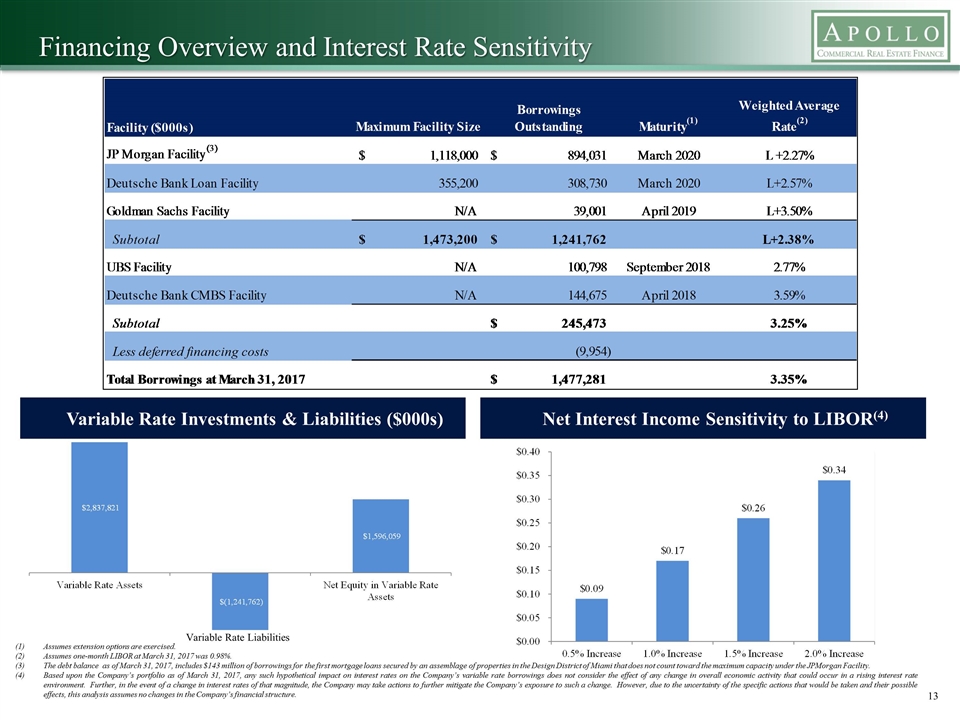
Financing Overview and Interest Rate Sensitivity Variable Rate Investments & Liabilities ($000s) Variable Rate Liabilities Assumes extension options are exercised. Assumes one-month LIBOR at March 31, 2017 was 0.98%. The debt balance as of March 31, 2017, includes $143 million of borrowings for the first mortgage loans secured by an assemblage of properties in the Design District of Miami that does not count toward the maximum capacity under the JPMorgan Facility. Based upon the Company’s portfolio as of March 31, 2017, any such hypothetical impact on interest rates on the Company’s variable rate borrowings does not consider the effect of any change in overall economic activity that could occur in a rising interest rate environment. Further, in the event of a change in interest rates of that magnitude, the Company may take actions to further mitigate the Company’s exposure to such a change. However, due to the uncertainty of the specific actions that would be taken and their possible effects, this analysis assumes no changes in the Company’s financial structure. Net Interest Income Sensitivity to LIBOR(4)
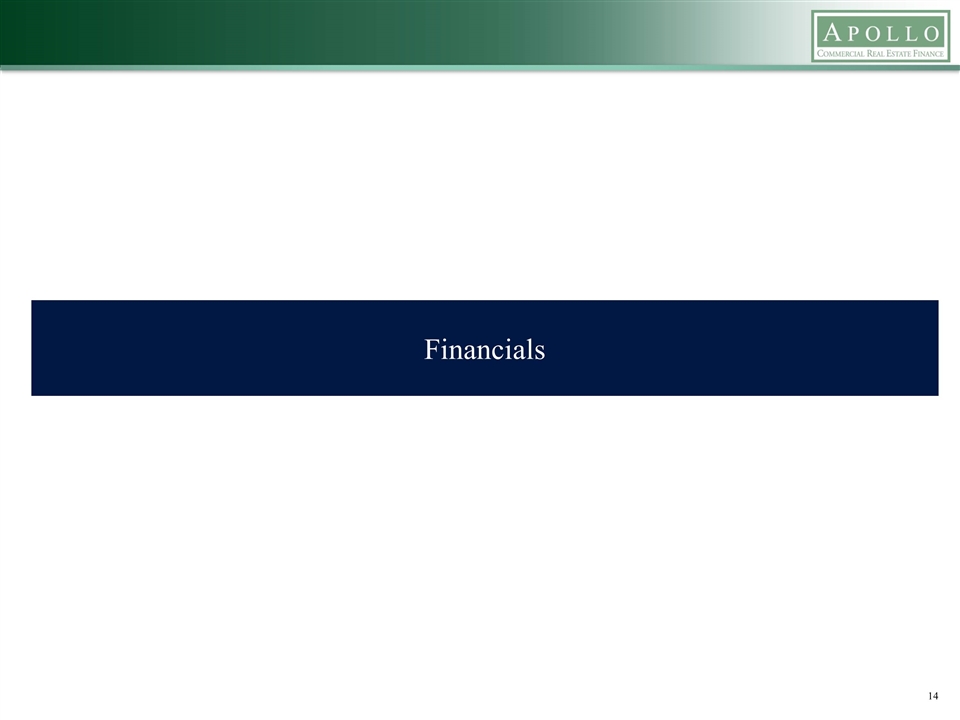
Financials
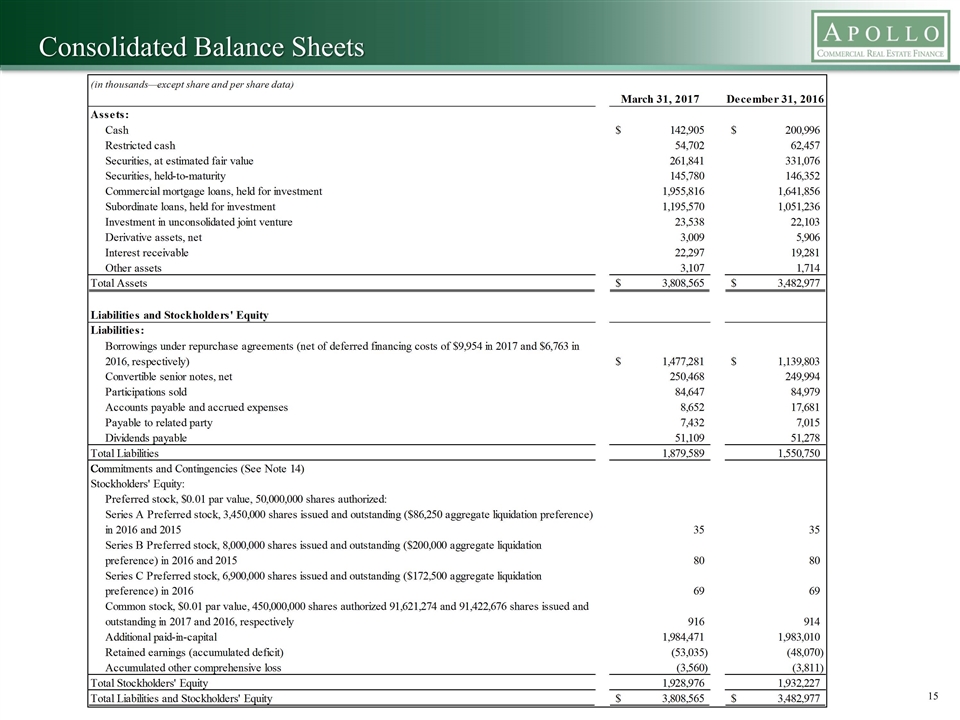
Consolidated Balance Sheets
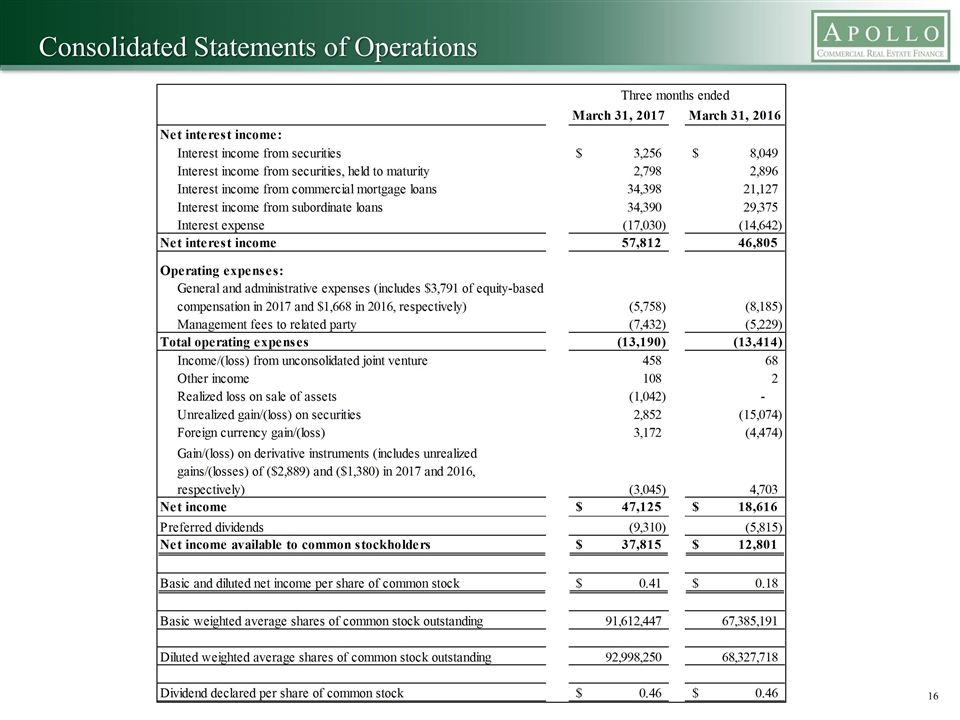
Consolidated Statements of Operations
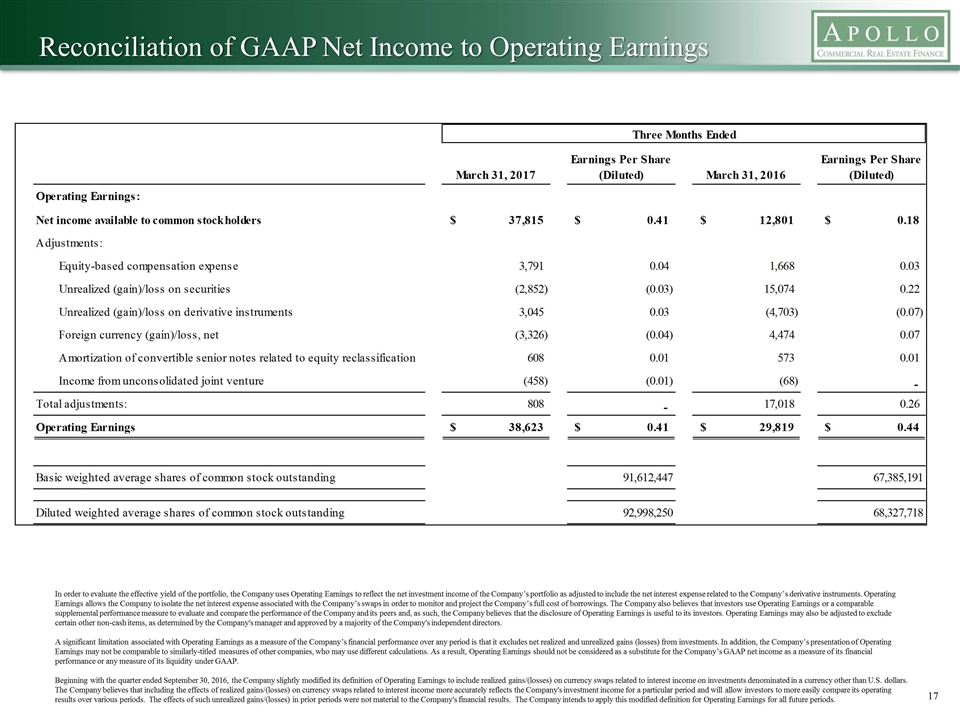
Reconciliation of GAAP Net Income to Operating Earnings In order to evaluate the effective yield of the portfolio, the Company uses Operating Earnings to reflect the net investment income of the Company’s portfolio as adjusted to include the net interest expense related to the Company’s derivative instruments. Operating Earnings allows the Company to isolate the net interest expense associated with the Company’s swaps in order to monitor and project the Company’s full cost of borrowings. The Company also believes that investors use Operating Earnings or a comparable supplemental performance measure to evaluate and compare the performance of the Company and its peers and, as such, the Company believes that the disclosure of Operating Earnings is useful to its investors. Operating Earnings may also be adjusted to exclude certain other non-cash items, as determined by the Company's manager and approved by a majority of the Company's independent directors. A significant limitation associated with Operating Earnings as a measure of the Company’s financial performance over any period is that it excludes net realized and unrealized gains (losses) from investments. In addition, the Company’s presentation of Operating Earnings may not be comparable to similarly-titled measures of other companies, who may use different calculations. As a result, Operating Earnings should not be considered as a substitute for the Company’s GAAP net income as a measure of its financial performance or any measure of its liquidity under GAAP. Beginning with the quarter ended September 30, 2016, the Company slightly modified its definition of Operating Earnings to include realized gains/(losses) on currency swaps related to interest income on investments denominated in a currency other than U.S. dollars. The Company believes that including the effects of realized gains/(losses) on currency swaps related to interest income more accurately reflects the Company's investment income for a particular period and will allow investors to more easily compare its operating results over various periods. The effects of such unrealized gains/(losses) in prior periods were not material to the Company's financial results. The Company intends to apply this modified definition for Operating Earnings for all future periods.
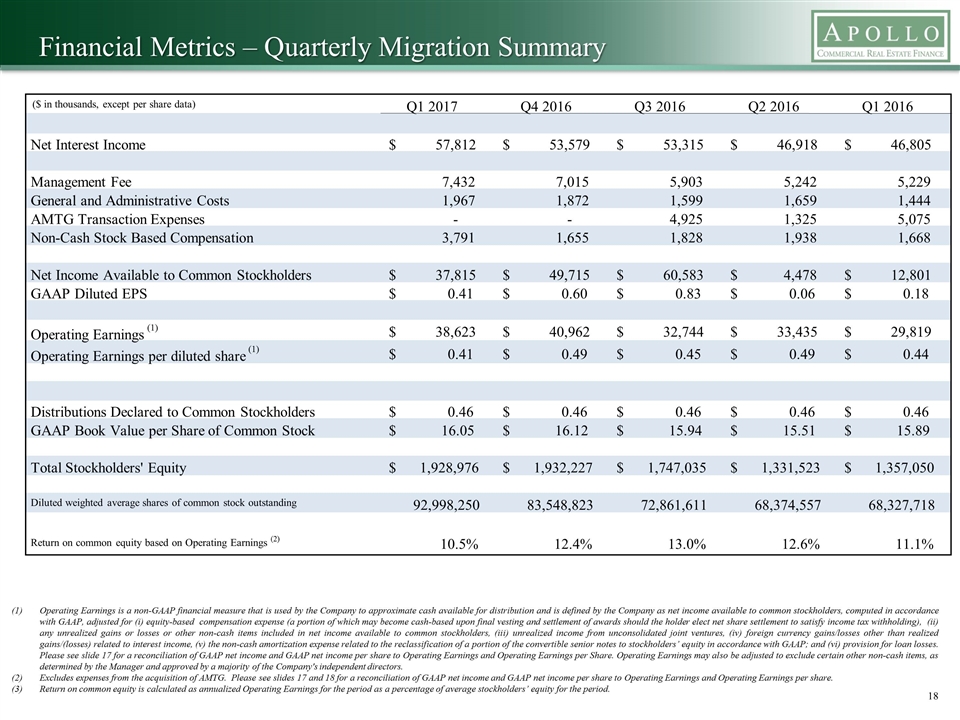
Financial Metrics – Quarterly Migration Summary Operating Earnings is a non-GAAP financial measure that is used by the Company to approximate cash available for distribution and is defined by the Company as net income available to common stockholders, computed in accordance with GAAP, adjusted for (i) equity-based compensation expense (a portion of which may become cash-based upon final vesting and settlement of awards should the holder elect net share settlement to satisfy income tax withholding), (ii) any unrealized gains or losses or other non-cash items included in net income available to common stockholders, (iii) unrealized income from unconsolidated joint ventures, (iv) foreign currency gains/losses other than realized gains/(losses) related to interest income, (v) the non-cash amortization expense related to the reclassification of a portion of the convertible senior notes to stockholders’ equity in accordance with GAAP; and (vi) provision for loan losses. Please see slide 17 for a reconciliation of GAAP net income and GAAP net income per share to Operating Earnings and Operating Earnings per Share. Operating Earnings may also be adjusted to exclude certain other non-cash items, as determined by the Manager and approved by a majority of the Company's independent directors. Excludes expenses from the acquisition of AMTG. Please see slides 17 and 18 for a reconciliation of GAAP net income and GAAP net income per share to Operating Earnings and Operating Earnings per share. Return on common equity is calculated as annualized Operating Earnings for the period as a percentage of average stockholders’ equity for the period. ($ in thousands, except per share data) Q1 2017 Q4 2016 Q3 2016 Q2 2016 Q1 2016 Net Interest Income 57,812 $ 53,579 $ 53,315 $ 46,918 $ 46,805 $ Management Fee 7,432 7,015 5,903 5,242 5,229 General and Administrative Costs 1,967 1,872 1,599 1,659 1,444 AMTG Transaction Expenses - - 4,925 1,325 5,075 Non-Cash Stock Based Compensation 3,791 1,655 1,828 1,938 1,668 Net Income Available to Common Stockholders 37,815 $ 49,715 $ 60,583 $ 4,478 $ 12,801 $ GAAP Diluted EPS 0.41 $ 0.60 $ 0.83 $ 0.06 $ 0.18 $ Operating Earnings (1) 38,623 $ 40,962 $ 32,744 $ 33,435 $ 29,819 $ Operating Earnings per diluted share (1) 0.41 $ 0.49 $ 0.45 $ 0.49 $ 0.44 $ Distributions Declared to Common Stockholders 0.46 $ 0.46 $ 0.46 $ 0.46 $ 0.46 $ GAAP Book Value per Share of Common Stock 16.05 $ 16.12 $ 15.94 $ 15.51 $ 15.89 $ Total Stockholders' Equity 1,928,976 $ 1,932,227 $ 1,747,035 $ 1,331,523 $ 1,357,050 $ Diluted weighted average shares of common stock outstanding 92,998,250 83,548,823 72,861,611 68,374,557 68,327,718 Return on common equity based on Operating Earnings (2) 10.5% 12.4% 13.0% 12.6% 11.1%
